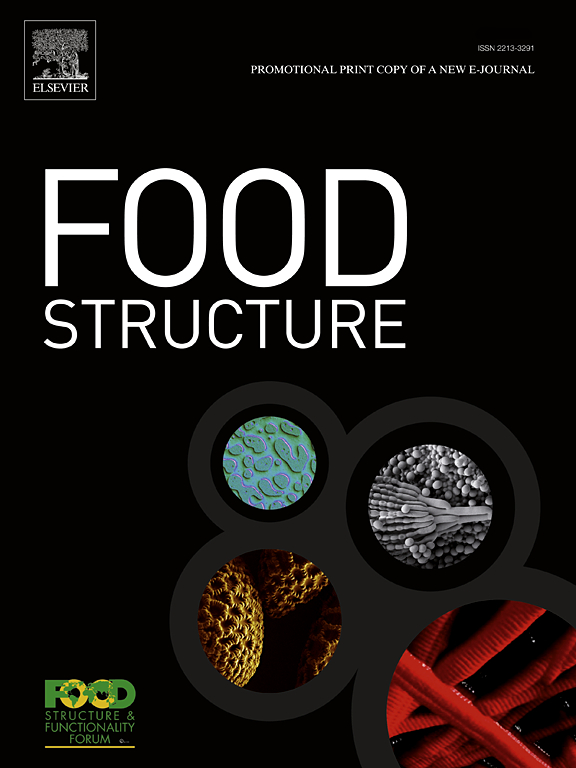Soy lecithin strengthens amaranth protein-based omelettes through protein complexation which alters protein interactions
IF 5.9
3区 农林科学
Q1 FOOD SCIENCE & TECHNOLOGY
引用次数: 0
Abstract
A plant-based omelette with comparable texture and protein content could more effectively address egg shortages. To strengthen the plant-based omelette prepared by frying an amaranth-protein-stabilised emulsion, with protein (11.6 %) and lipid (9.74 %) contents similar to eggs, the effect of adding soy lecithin (0.50–2.00 % w/w) to the emulsion was investigated. This approach was promising given the structural and conformational changes reportedly induced by soy lecithin upon complexation with various plant proteins. Confocal imaging and the binding energy of soy phosphatidylcholine to 11S globulin (-6.01 kcal/mol) indicated complexation between lecithin phospholipids and the proteins. This complexation exposed amino acids, including tryptophan and tyrosine, from the hydrophobic core, thereby promoting hydrogen bonding involving 7S globulin, 11S globulin, and albumin. Consequently, intermolecular β-sheet content rose from 21.5 % to 25.5 % with increasing lecithin content in the plant-based omelette. Enhanced aggregation of 11S globulin and albumin, along with lecithin-induced sulfhydryl group exposure, promoted disulfide bond formation (25.8–30.9 %) upon heating. These interactions improved protein network connectivity under SEM, such that increasing lecithin content strengthened the plant-based omelette. The plant-based omelette containing 1.0 % lecithin had the closest texture to the egg omelette, with distinguishing parameters including dynamic consistency index (94.1 vs. 95.6 kPa·sn*) and maximum creep compliance (6.12 vs. 5.98 [×10⁻⁶ Pa⁻¹]) for viscoelastic properties, along with ultimate tensile strength (22.1 vs. 21.9 kPa). As a healthy option with a similar texture, this plant-based omelette could appeal to consumers seeking sustainable, animal-friendly egg alternatives. This study demonstrated the potential of lecithin in texturing plant protein-based foods.
大豆卵磷脂通过改变蛋白质相互作用的蛋白质络合来增强苋菜蛋白为基础的煎蛋
以植物为基础的煎蛋具有类似的质地和蛋白质含量,可以更有效地解决鸡蛋短缺问题。为强化蛋白(11.6 %)和脂质(9.74 %)含量与鸡蛋相似的苋菜蛋白稳定乳状液制备的植物性煎蛋,研究了在乳状液中添加大豆卵磷脂(0.50-2.00 % w/w)的效果。考虑到大豆卵磷脂与各种植物蛋白络合后引起的结构和构象变化,这种方法是有希望的。共聚焦成像和大豆磷脂酰胆碱与11S球蛋白的结合能(-6.01 kcal/mol)表明卵磷脂磷脂与蛋白质之间存在络合作用。这种络合作用使氨基酸,包括色氨酸和酪氨酸,从疏水核心暴露出来,从而促进涉及7S球蛋白、11S球蛋白和白蛋白的氢键。因此,随着卵磷脂含量的增加,分子间β片含量从21.5 %增加到25.5 %。11S球蛋白和白蛋白的聚集增强,以及卵磷脂诱导的巯基暴露,促进了加热后二硫键的形成(25.8-30.9 %)。这些相互作用改善了扫描电镜下蛋白质网络的连通性,因此增加卵磷脂含量可以增强植物性煎蛋。含有1.0 %卵磷脂的植物煎蛋与鸡蛋煎蛋的口感最接近,其区分参数包括动态一致性指数(94.1 vs 95.6 kPa·sn*)和最大蠕变柔度(6.12 vs 5.98 [×10⁻26 Pa⁻¹])的粘弹性特性,以及极限拉伸强度(22.1 vs 21.9 kPa)。作为一种具有类似质地的健康选择,这种以植物为基础的煎蛋卷可能会吸引寻求可持续的、对动物友好的鸡蛋替代品的消费者。这项研究证明了卵磷脂在植物蛋白类食品的纹理化中的潜力。
本文章由计算机程序翻译,如有差异,请以英文原文为准。
求助全文
约1分钟内获得全文
求助全文
来源期刊

Food Structure-Netherlands
Chemical Engineering-Bioengineering
CiteScore
7.20
自引率
0.00%
发文量
48
期刊介绍:
Food Structure is the premier international forum devoted to the publication of high-quality original research on food structure. The focus of this journal is on food structure in the context of its relationship with molecular composition, processing and macroscopic properties (e.g., shelf stability, sensory properties, etc.). Manuscripts that only report qualitative findings and micrographs and that lack sound hypothesis-driven, quantitative structure-function research are not accepted. Significance of the research findings for the food science community and/or industry must also be highlighted.
 求助内容:
求助内容: 应助结果提醒方式:
应助结果提醒方式:


